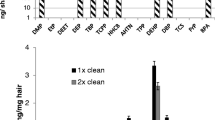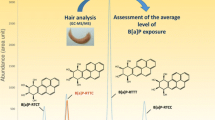Summary
Different incubation and extraction methods have been evaluated for determination of isomers of PCBs, DDT, and HCH in human hair. The best method was found to be overnight incubation in 3 M HCl at 40°C and liquid-liquid extraction with 4:1 hexane-dichloromethane. After clean-up on basic alumina and acid silica, the extract was analysed by GC-ECD or GC-MS. Recoveries of internal standards and the analytes under investigation ranged between 87 and 111%. Limits of detection were between 0.5 and 1 ng g−1 hair for ECD and 1 to 3 ng g−1 for MS. Good linearity (r 2>0.999) was achieved for the ranges tested (1–30 ng g−1 for individual PCBs, 1–1000 ng g−1 for DDT isomers, and 1–100 ng g−1 hair for HCH isomers). There was no difference between the efficiency of extraction from powdered and cut hair. Similar PCBs profiles were found in human hair and in other parts of the body. Similar concentrations of persistent organic pollutants (POP; reported relative to the amount of lipid) were found in human milk and in hair from the same person. Concentrations of organochlorine compounds were measured, by use of the method, in several samples from Belgium, Romania, and Greece. It was concluded that hair can be used to monitor any subgroup of the population, with emphasis on those from which sampling of milk, adipose tissue, or blood is not possible, or is very difficult (e.g. children).
Similar content being viewed by others
References
Pauwels, A.; Covaci, A.; Delbeke, L.; Punjabi, U.; Schepens, P.Chemosphere 1999,39 (14), 2433–2441.
Covaci, A.; Pauwels, A.; Schepens, P.Intern. J. Environ. Anal. Chem. 2000,76(3), 167–178.
Pauwels, A.; Covaci, A.; Weyler, J.; Delbeke, L.; Dhont, M.; De Sutter, P.; D'Hooghe, T.; Schepens, P.Arch. Environ. Contam. Toxicol. 2000,39(2), 265–270.
Lunden, A.; Noren, K.Arch. Environ. Contam. Toxicol. 1998,34, 414–423.
Schramm, K.W.; Kuettner, T.; Weber, S.; Lutzke, K.Chemosphere 1992,24(3), 351–358.
Bencze, K.Fresenius J. Anal. Chem. 1990,337, 867–876.
Spearman, R.I.C. InThe Physiology and Pathophysiology of the Skin: Jarrett, A., Ed., Academic Press, London,1977.
Ohgami, T.; Nonaka, S.; Murayama, F.; Irifune, H.; Watanabe, M.; Tsukazaki, N.; Tanaka, K.; Yoshida, H.; Rikioka, Y.Fukuoka Igaku Zasshi 1989,80, 307–312.
Ohgami, T.; Nonaka, S.; Irifune, H.; Watanabe, M.; Tsukazaki, N.; Tanaka, K.; Yano, M.; Yoshida, H.; Murayama, F.; Rikioka, Y.Fukuoka Igaku Zasshi 1991,82, 295–299.
Neuber, K.; Merkel, G.; Randow, F.F.E.Toxicol. Lett. 1999,107, 189–192.
Zupancic-Kralj, L.; Jan, J.; Marsel, J.Chemosphere 1992,25(12), 1861–1867.
Dauberschmidt, C.; Wenning, R.J. Anal. Toxicol. 1999,22, 610–611.
Schramm, K.W.Bull. Environ. Contam. Toxicol. 1997,59, 396–402.
Schramm, K.W.Biomonitoring ausgewählter organischer Chemikalien mit Haaren, Herbert Utz, München,1999.
Frame, G.Fresenius J. Anal. Chem. 1997,357, 701–722.
Klein, U.; Drochner, W.; Forschner, E.; Johannes, B.Dtsch. Tierarztl. Wschr. 1992,99(6), 242–248.
Author information
Authors and Affiliations
Rights and permissions
About this article
Cite this article
Covaci, A., Schepens, P. Chromatographic aspects of the analysis of selected persistent organochlorine pollutants in human hair. Chromatographia 53 (Suppl 1), S366–S371 (2001). https://doi.org/10.1007/BF02490358
Received:
Revised:
Accepted:
Issue Date:
DOI: https://doi.org/10.1007/BF02490358




